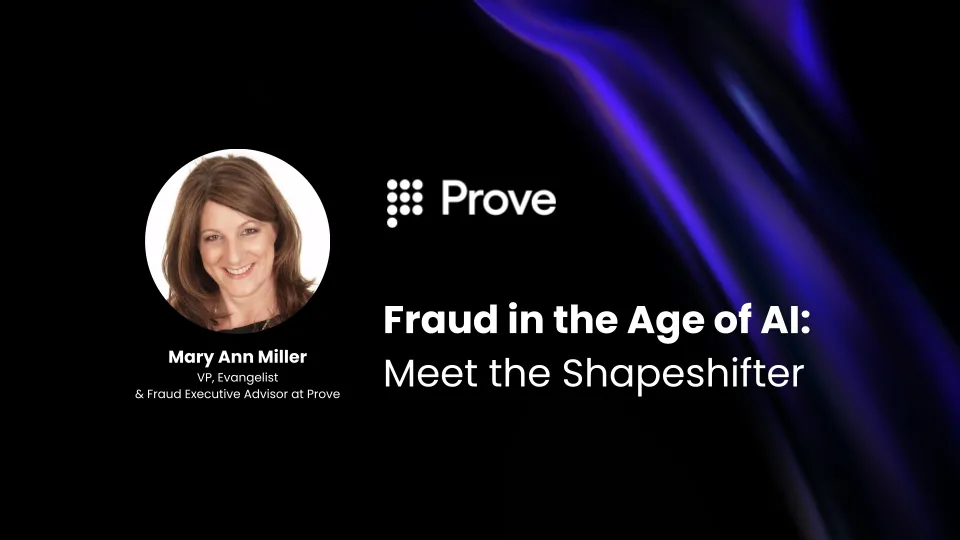Fraud in the Age of AI: Meet the Shapeshifter


The COVID-19 pandemic not only changed the way we work and live, it also unleashed a wave of fraud unlike anything we've seen before. A staggering $242 billion was stolen across 100,000 fraud channels, perpetrated by an estimated 1 million new fraudsters. Welcome to the age of the Shapeshifter.
Who is the Shapeshifter?
The Shapeshifter isn't a single person, but a new breed of fraudster empowered by technology and emboldened by a world in flux. These criminals are not the stereotypical scammers we once pictured; they are digital chameleons, constantly adapting and evolving their tactics to exploit the weaknesses in our systems and our trust.
The Shapeshifter thrives in the anonymity of the internet, using a variety of tools and encrypted communication channels to operate with impunity. They are adept at leveraging readily available artificial intelligence to amplify their scams, creating convincing deepfakes, crafting sophisticated phishing schemes, and even generating realistic synthetic identities. Their agility allows them to pivot from one attack vector to another with lightning speed, always staying one step ahead of authorities and security measures.
Perhaps most alarmingly, the Shapeshifter operates with a brazen confidence, fueled by the perceived lack of consequences. The sheer scale of their activities has overwhelmed law enforcement, creating an environment where many feel they can act without fear of retribution. This sense of invincibility has led to increasingly audacious scams, from elaborate business email compromises to devastating ransomware attacks. The Shapeshifter is not just a threat to our financial security, but a challenge to the trust that underpins our digital society.
These aren't your average scammers. Shapeshifters are:
- Powered by AI: They leverage readily available artificial intelligence tools to enhance their scams.
- Instantly Networked: Platforms like Telegram provide instant communication and collaboration, allowing fraudsters to share tactics and targets rapidly.
- Agile Attackers: They can pivot their methods quickly, exploiting vulnerabilities across various platforms and industries.
- Emboldened by Impunity: The sheer scale of fraud, combined with overwhelmed law enforcement, has created an environment where consequences seem minimal.
Generative AI: The Shapeshifter's Secret Weapon
Generative AI, the technology that powers creative tools like ChatGPT and Google Gemini, has become the Shapeshifter's secret weapon. This cutting-edge technology enables these bad actors to create incredibly convincing fakes, blurring the lines between reality and fabrication.
Voice cloning, for example, allows the Shapeshifter to impersonate loved ones or trusted figures with alarming accuracy. This has led to a surge in scams involving fake kidnappings or urgent pleas for financial assistance, preying on our deepest fears and vulnerabilities.
Generative AI also enables the creation of near-perfect counterfeit documents. From forged paystubs used in loan applications to sophisticated fake IDs, these documents are virtually indistinguishable from the real thing, making it incredibly difficult for even trained professionals to detect the fraud.
These bad actors are also using generative AI to supercharge phishing attacks. By crafting personalized and persuasive emails, text messages, or social media posts, Shapeshifters can lure victims into clicking on malicious links, revealing sensitive information, or even transferring funds directly into the scammer's hands. These AI-generated messages are often so convincing that even the most vigilant individuals can fall prey to their deceptive tactics.
In essence, generative AI has given the Shapeshifter the power to manipulate our perception of reality, making it harder than ever to discern truth from falsehood. It's a powerful tool that, in the wrong hands, can cause immense financial and emotional harm. To combat this evolving threat, we must remain vigilant, educate ourselves about the latest scams, and invest in robust security measures that can keep pace with the Shapeshifter's ever-evolving arsenal of deception.
Generative AI, the technology behind tools like ChatGPT, is accelerating the use of fraud. It enables:
- Perfect Voice Clones: Services like Resemble.ai can create eerily realistic voice replicas, used for sophisticated scams like fake kidnappings.
- Better Fake Documents: Forged paystubs, IDs, and other documents are increasingly difficult to detect, with AI-powered tools making them virtually indistinguishable from the real thing.
- Perfect Phishing: AI-crafted phishing emails and messages are incredibly convincing, luring victims into revealing sensitive information.
Document Fraud Explosion: The Rise of Undetectable Fakes and Synthetic Identities
The integrity of documents, which used to be the foundation of trust in financial and legal systems, is under unprecedented assault. The proliferation of sophisticated forgery tools and the rise of digital manipulation techniques have made it increasingly difficult to distinguish between genuine and counterfeit documents. Let’s consider the following ways this is happening:
Fake Paystubs
The black market for fake paystubs is thriving, with sales tripling in recent years. These counterfeit documents, often generated using AI-powered tools, are designed to deceive employers, lenders, and government agencies. The level of detail and authenticity in these forgeries is so high that even experienced human eyes can struggle to spot the discrepancies. This poses a significant risk for businesses and individuals alike, as fake paystubs can be used to obtain loans, secure employment, or even defraud government benefit programs.
Synthetic Identity Fraud
This insidious form of fraud is rapidly gaining momentum. Criminals combine real and fabricated data to create entirely new identities, complete with social security numbers, credit histories, and even driver's licenses. These synthetic identities are then used to open fraudulent accounts, apply for loans, and perpetrate various financial crimes. The scale and complexity of synthetic identity fraud make it particularly challenging to detect and prosecute, as it often goes unnoticed until significant financial damage has been inflicted.
Suspicious Activity Reports (SARs)
These filings, mandated by law for financial institutions to report suspicious transactions, are skyrocketing. This surge in SARs reflects the growing volume and sophistication of financial crimes, including money laundering, terrorist financing, and fraud. While SARs are a crucial tool for law enforcement agencies, the sheer volume of these filings can overwhelm investigators, making it difficult to prioritize and pursue the most impactful cases. Additionally, the reliance on manual review of SARs can introduce delays and inefficiencies in the detection and prevention of financial crimes.
2024: What's Next for Fraud?
Fraud experts predict a tumultuous year ahead:
Wave of Insider Fraud: The traditional perimeter of security is crumbling from within. Disgruntled or financially motivated employees are increasingly becoming accomplices in sophisticated fraud schemes. This could manifest as:
- Sim Swap Attacks: Insiders at mobile carriers facilitate unauthorized SIM swaps, granting fraudsters access to victims' accounts and sensitive information.
- Bank Facilitators: Bank employees may be coerced or bribed to modify transaction records, authorize fraudulent withdrawals, or leak confidential customer data.
- Data Brokers: Rogue employees at data aggregation companies may sell sensitive information to fraudsters, fueling identity theft and account takeover attacks.
- Ecommerce Insiders: Employees at online retailers may manipulate order records, facilitate fraudulent returns, or steal customer payment details.
First-Party Fraud Bonanza: The rise of "friendly fraud" or "chargeback fraud" is set to explode. This involves legitimate customers colluding with fraudsters to dispute charges, claim refunds, or file false insurance claims. The ease of online transactions and the prevalence of digital wallets make this type of fraud increasingly attractive. Financial institutions and merchants will need to invest in sophisticated fraud detection systems that analyze behavioral patterns and transaction anomalies to identify these schemes.
- Commercial Fraud Exposed: The pandemic-era boom in property values, often fueled by speculative investments and relaxed lending standards, is expected to unwind. This could expose a wave of commercial fraud, including inflated property appraisals, falsified income statements, and fraudulent loan applications. As defaults rise, lenders and investors will need to conduct thorough due diligence and forensic accounting to uncover the extent of the fraud and mitigate losses.
- Account Purges: Financial institutions, grappling with an influx of synthetic identities and mule accounts used for money laundering and other illicit activities, may resort to mass account closures. While this may seem like a drastic measure, it could be seen as a necessary step to protect the integrity of the financial system. However, legitimate customers could be caught in the crossfire, leading to potential legal challenges and reputational damage for the institutions.
- Crypto Crackdown: The collapse of major crypto exchanges like FTX and the regulatory scrutiny faced by Binance have ushered in a new era of stricter oversight for the crypto industry. Expect a wave of new regulations targeting anti-money laundering (AML) and know-your-customer (KYC) compliance. This could lead to increased friction for users, but it's a necessary step to curb illicit activities like money laundering, terrorist financing, and tax evasion that have plagued the crypto space.
- Social Media Accountability: Social media platforms like Meta and Telegram, often criticized for their lax approach to content moderation, are facing mounting pressure to curb the spread of scams and disinformation. Governments and regulators are increasingly holding these platforms accountable for the harmful content they host. This could lead to stricter content moderation policies, algorithmic adjustments to limit the reach of fraudulent content, and even legal liability for platforms that fail to take adequate action.
- Supply Chain Attacks: Fraudsters are becoming increasingly sophisticated, targeting not just individual companies but the entire supply chain. This could involve compromising third-party vendors, infiltrating software systems, or even bribing employees to gain access to sensitive data or disrupt operations. These attacks are often difficult to detect and can have devastating consequences, including financial losses, data breaches, and reputational damage. Companies will need to adopt a holistic approach to security, vetting their partners thoroughly, implementing robust access controls, and monitoring their systems for suspicious activity.
The Bottom Line
Fraud in the age of AI is a complex and evolving landscape. Staying informed and vigilant is crucial for individuals and businesses alike. As fraudsters become more sophisticated, so too must our defenses.
Remember: Knowledge is your first line of defense. By understanding the tactics used by shapeshifting scammers, we can better protect ourselves and our assets.

Keep reading
 Read the article: Prove Launches Global Identity Graph to Redefine Digital Trust for 90% of Digital Consumers
Read the article: Prove Launches Global Identity Graph to Redefine Digital Trust for 90% of Digital ConsumersProve has launched its Global Identity Graph, a foundational platform that connects verified human identities to their digital tokens, redefining digital trust and enabling instant, frictionless, and secure engagement for over 90% of digital consumers worldwide.
 Read the article: Prove Partners with Hard Rock Bet to Deliver Elite Onboarding and Enhance Player Experience
Read the article: Prove Partners with Hard Rock Bet to Deliver Elite Onboarding and Enhance Player ExperienceProve and Hard Rock Bet partner to deliver elite player onboarding by using Prove Pre-Fill® to instantly verify identities, streamline signup, and enhance security in online gaming.
 Read the article: Prove and Backbase Partner to Enable Faster and Safer Onboarding for Financial Institutions
Read the article: Prove and Backbase Partner to Enable Faster and Safer Onboarding for Financial InstitutionsThe Prove Pre-Fill solution integrates with Backbase’s AI-powered Banking Platform to reduce fraud, streamline data entry, and improve digital account opening experiences.












